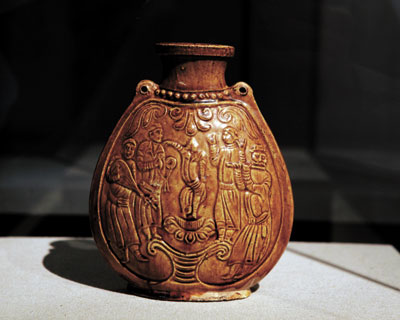
Cao Zhen
caozhen0806@126.com
AN exhibition of cultural relics unearthed from Central China’s Henan Province is being held at the Shenzhen Museum’s Civic Center outlet.
Featuring a spectacular selection of articles for daily use or to be buried with the dead, the exhibits span from the Han Dynasty (206 B.C.-A.D. 220) to the Tang Dynasty (618-907) and showcase the fascinating culture of Henan — China’s cradle of civilization.
Situated in the middle reaches of the Yellow River where people lived thousands of years ago, Henan was one of the most significant areas during the rise of early China. Three of China’s seven ancient capitals were in Henan: Luoyang, Kaifeng and Anyang. “Because of this, Henan is one of the few provinces that has many historical relics in the country,” said Guo Xuelei, vice curator of the Shenzhen Museum.
On loan from the Henan Provincial Museum, the 190 works in the exhibition include elegant porcelains, colorful stone paintings, stele inscriptions, stone rubbings, stunning architectural models, vivid pottery figurines and exquisite Buddha sculptures.
Among the highlights of the exhibition are pottery architectural models that were buried with the dead during the Han Dynasty. From the carefully constructed main house and tower with its brightly colored exterior to the enclosed courtyard with a model dog, a pig and birds on the roof, the level of detail shown in the architectural models is impressive.
“Actual remains of ancient Chinese domestic architecture are rare. These imposing models of manor houses show all the essential features of Han architecture and provide us with a good idea of what the domestic compounds of the time looked like, as well as the various activities that were carried out within them,” said Qiao Wenjie, an ancient art researcher for the Shenzhen Museum.
The basic unit of a manor house model is an enclosure defined by four corner piers with a widely overhanging tile roof supported by a system of cantilevered brackets. In addition, the house has a second roof over the first story, which is elevated on a stepped platform, an exterior staircase, elaborate latticework screens that shield the third story and a covered bridge extending from the third floor of the main tower to the smaller watchtower.
“Many Han Dynasty tombs were equipped with the necessities of everyday life, including furniture, cooking utensils and even a model of a multi-story manor house — items thought to provide comfort and ease for the soul’s transition to the afterlife. These, however, would only have been buried with the wealthiest of people in Han society,” said Qiao.
Another group of must-see art pieces are bricks with colorful engraved patterns unearthed from a tomb that dates back to the Northern and Southern Dynasties (420-589) in Henan’s Dengxian County. Motifs include figures and animals, as well as production and living activities such as plowing, sowing, harvesting, herding, banquets, and entertainment. There are also depictions of mythological scenes and legendary figures.
According to Qiao, the practice of engraving patterns on bricks used for tomb construction originated in the late Warring States Period (475-221 B.C.). It reached its zenith in the Han Dynasty and remained popular as late as the Northern and Southern Dynasties period. The patterns are either shallow reliefs created using wooden molds or incised or raised outlines carved on bricks before they were fired in a kiln. Some of them are also painted red, green and white.
At the exhibition, visitors can also admire various ceramic wares in white, yellow and green glazes, as well as stele inscriptions and stone rubbings.
Steles at tombs or temples are generally rectangular stone tablets upon which Chinese characters are carved intaglio with commemorative text or poems. “Important inscriptions penned by eminent statesmen, men of letters or other public figures and engraved by master masons were cherished as valuable relics, important to the study of ancient literature and calligraphy,” said Qiao.
During the exhibition period, Shenzhen Museum staff members will demonstrate stone rubbing techniques every Saturday afternoon and invite visitors to join in the activities. Stone rubbing is the practice of creating an image of surface features of a stone on paper. The image records features such as natural textures, inscribed patterns or lettering. For an artist, stone rubbings can become an entire body of creative work.
Dates: Until July 12
Hours: 10 a.m.-6 p.m. Closed Mondays
Venue: Shenzhen Museum, Block A, Civic Center, Futian District (福田区市民中心A区深圳博物馆新馆)
Metro: Shekou or Longhua Line, Civic Center Station (市民中心站), Exit B
|

